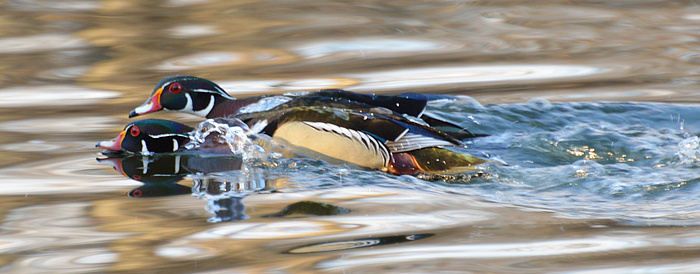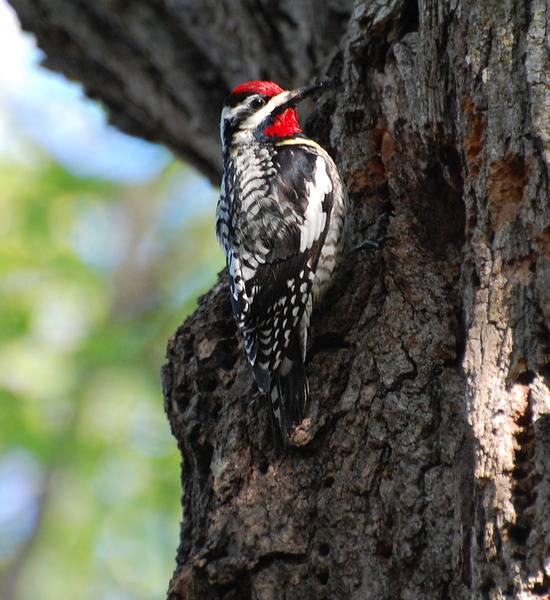
Sunset Wood Ducks
April 30th, 2015
Testosterone fever at Mud Lake yesterday evening, with drake mallards and drake wood ducks putting on a show. Actually most of the ducks are paired up already, but that's not stopping hopeful third parties doing their best to wedge themselves in! At one point, a pair of male mallards swam around a lone female, bills raised, going "quack. quack. quack." with the most exquisite air of self-importance. It was enough that I and the photographer next to me, formerly too engrossed in our work to pay much attention to each other, had to look at each other and laugh.
People feed the ducks at the north shore, to draw them closer in. I have mixed feelings about it--on the one hand I prefer seeing birds wild, but on the other hand, the photographer in me loves it! (Also on the other hand, it's been a hard, slow spring, and I'm sure they need all the extra food they can get.) You need only kneel down on the rocks, and soon the throng approaches in anticipation of cracked corn. If you don't feed them, they go back to their business, but stay close for awhile just in case, making for some nice photo ops as the drakes pose, preen, dabble, and occasionally tear off racing each other across the water.

1680x1050 wallpaper

1680x1050 wallpaper
Crest fully poofed-out. I only ever see them like that in spring.

1680x1050 wallpaper

Sleepy Screech Owl
April 28th, 2015
These little guys can be remarkably well-camouflaged if you don't know to look for them! Eastern Screech-Owls roost and nest in old woodpecker holes. They look very cute and innocent when you catch one by day. By night, they prey on small birds and mammals, and make a sound that raises goosebumps on your skin.

This is an Ottawa-lister for me (i.e. the first time I've found one in Ottawa.) I'd previously seen screech owls a few times on birding trips to Point Pelee.
Here's a higher-res version.
Oil Beetle
April 25th, 2015

I couldn't tell much about this beetle by naked eye. It just looked like it was clambering around in the grass. But it took on a lot more personality under the zoom lens. I have seldom seen a creature eat with as much gusto as it was eating on that grass stalk--you could almost hear the "OM NOM NOM" sounds.
Oil beetles (also called blister beetles) have a fascinating start to life. Once they hatch, the larvae will climb up a flower stalk and gather in a mass that roughly approximates the shape of a bee, while also emitting a fake female-bee-pheromone smell (which species of bee depends on which species of oil beetle.) When a male comes and attempts to mate with this trojan bee, the larvae separate and climb onto him, and then when he finds a real female bee to mate with, climb onto her. They finally end up in the underground nest where she lays her eggs, where they will proceed to eat the honey and pollen she provisioned her young with, and then eat the eggs too.
Spring Display
April 20th, 2015

1680x1050 wallpaper
Return Of The Night Herons
April 18th, 2015
Black-Crowned Night Herons are back at Mud Lake. These stocky red-eyed herons have been some of my favorite birds since I saw my first at Vincent Massey Park almost eight years ago. It was the bird that told me I had outgrown my beginner's field guide--the first one I found that was too uncommon to be in there.
This one had been foraging in the east swamp around sunset (their favorite time of day), but took to the trees as I approached. Those white things draped down its shoulders are breeding plumes.


Springtime Strut
April 13th, 2015
Spring has finally sprung (for real this time?) and birds are coming back to Ottawa in numbers. I went out to Shirley's Bay after sunset on Saturday searching for woodcocks. When I spotted Gillian Mastromatteo out of her car at the side of the road, I knew something interesting must be afoot! I pulled over, and sure enough as soon as I stepped out of the car I heard that telltale buzzy "peent!"--the same one I heard in the Algonquin tract three days prior.
As is typical for woodcocks, we couldn't find him. Though he sounded like he was just off the road, and there was still plenty of light in the sky, we stood there for some fifteen minutes poring over every inch of the scenery without success. But then he took off, and there was no missing him! We both watched as he flew a wide circle high in the sky above us, wings twittering. ("He looks like a big hummingbird!" Gillian said. "He looks like a big bat!" I said.) Then he descended steeply back into the brush whence he came. Having seen his descent, we were quickly able to spot him on the ground, and watch him "peent" around for another five minutes before his next flight.
The skydance, they say, stokes the interest of female woodcocks, and eventually, one will land in the brush next to the peenting male and he'll court her, bowing and strutting. I've never yet seen that for myself.
The subject of strutting birds leads me to my latest springtime excitement, my first-ever sighting of a male Wild Turkey in full display. Michael's keen eyes are to thank for this one. We were driving down Sixth Line when he saw something big in the farmer's field--either livestock or Wild Turkeys, he figured. It was turkeys, and the lone tom was strutting around in front of the hens, fanning his tail. He was resplendent. Compared to the bland-looking turkeys I'm used to seeing (hens and nonbreeding males), I couldn't believe how colorful he was. Electric blue face, cherry red wattles, and all-over iridescent.
After a long hiatus from nature photography, I now have a new camera (Nikon D3200.) I think it's about time to start breaking it in.
The Price Of A Hard Winter
April 8th, 2015
There are a few weedy little tracts near where I live owned by Algonquin college. As a rule they host no birds of any great interest. But this evening, walking home from dinner, I heard a distinctive buzzy "peent!" coming from one of those tracts. There are only two creatures in North America that make precisely that sound, and only one that makes it while on land: American Woodcock!
In fact there was more than one of them. Woodcocks are solitary, secretive and very wild birds, usually found in places where few people go. But this evening two, maybe three of them were crammed into a tiny parcel of undeveloped land amidst the suburbs. Not coincidentally, this article was recently shared on OFNC Facebook. Woodcocks are starving in Nova Scotia for lack of open ground to feed on. They can't dig up the grubs and worms they eat when the ground is still blanketed in snow.
I think and hope that things are a little less dire for them here. The ones I found might be waiting out the slow thaw at Shirley's Bay. (Michael and I went hiking there a few days ago and ended up regretting that we hadn't worn winter boots. Large swaths of it were clear, but far from all.) The tract is completely thawed and thus presumably they can find food and drink there. It's interesting, because I've looked at those bits of land now and then and thought "might as well develop them, they're of no great use to wildlife." Today I've been proven wrong. Tiny undeveloped islands of land sometimes do matter.
Here's hoping the thaw soon accelerates, and I soon hear the twitter of skydancing woodcocks above Rifle Road!
Signs Of Spring
March 25th, 2015
Many signs of spring lately in Ottawa, despite the continued wintry weather. A porcupine in a tree along Carling (every March it seems they come out there to gnaw on birch bark), two Red-Winged Blackbirds at the Hilda feeders, Ring-Billed Gulls back in the parking lots, and a lone Turkey Vulture soaring about Kanata.
...and, at my balcony feeder, goldfinches molting out of their drab winter colors into fluorescent yellow breeding finery!


This guy seems to have molted his tail feathers all at once.

Common Redpolls at left and top. The two species have been faithful customers at my feeders all winter, often visiting by the dozens. The feisty and very hungry redpolls often edged out the goldfinches, but with spring coming, they will soon be heading back north and leaving our resident birds in peace.
A morning at South March (part 4)
July 27th, 2014
My last set of photos for awhile. If you should ever want to visit this beautiful forest, a trail map is available online. The main entrance is at Second Line and Klondike.

1680x1050 wallpaper
Generous sprays of Wild Columbine bloom in the exposed rocky areas of South March. It's one of my favorite wildflowers, and not one you see just anywhere.

Northern Flicker.

That's white trillium behind the chipmunk--it positively blankets parts of the forest in spring.

Unique vegetation on the sandstone barren north of Heron Pond. Nighthawks dive over this area in spring, and wild (edible) wintergreen berries grow in abundance. Unfortunately, this part of the forest, as well as a large chunk of the pond, is owned by a developer and could easily be lost.
A morning at South March (part 3)
July 22nd, 2014

1680x1050 wallpaper
Another sapsucker. You can see some old sap wells in this tree, as well as larger holes probably created by other woodpeckers. Sapsuckers are distinguished from their more common cousins, Downy and Hairy Woodpeckers, by their bright red chins (only on adult males) and by the broad white stripes on their sides. Their call is a nasal mew.

1680x1050 wallpaper
Wood Thrushes are one of the most beautiful songsters of deep woods, but to actually see one is a rare treat. They are often elusive, and this is my first-ever photo. I think it's a female, actually. I could hear her mate singing nearby.

A Veery in veery heaven: rich, mossy wet woods. Veeries are thrushes with a descending waterfall of a song. In the wee hours of morning and evening, they and the Wood Thrushes duet in South March Conservation Forest. If you're lucky, a Hermit Thrush might join in and make it a trio (usually a distant Hermit Thrush as they have different tastes in habitat from the other two.) I feel anyone with even a passing love of nature should hear a thrush symphony at least once in their life.

1680x1050 wallpaper
I tracked this "Baltimore Titmouse" (a Baltimore Oriole with a titmouse-like song) a ways into the woods, following his song up a hillside and into a sunny clearing, where he stood resplendent in the morning light.
|
